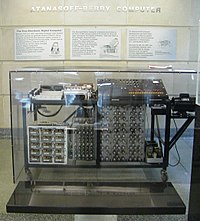
Photo from wikipedia
HYPOTHESIS Droplet depositing onto hot surfaces above the so-called Leidenfrost temperature will float on a cushion of its own vapor. The vapor flow below the drop could be rectified by… Click to show full abstract
HYPOTHESIS Droplet depositing onto hot surfaces above the so-called Leidenfrost temperature will float on a cushion of its own vapor. The vapor flow below the drop could be rectified by asymmetric surface textures, resulting the self-propelled droplet motion. Asymmetric structures like ratchets are used to rectify Leidenfrost droplet movement. Hence, it is possible to enhance the droplet mobility using surfaces with combined asymmetric macro/micro-structures. EXPERIMENTS Continuous scale-like microcraters stacked end-to-end were fabricated on steel surfaces by wire electrical discharge machining (WEDM). The crater orientation always vectored towards the machining direction (MD), which oriented the droplet motion. Further, by integrating micro and macro-ratchets, dual-scale ratchets were constructed by one-step process using WEDM. The travelling velocities of Leidenfrost droplets on dual-scale and traditional single-scale ratchets were compared and the enhanced mechanism on dual-scale ratchets was analyzed. FINDINGS One-step process was developed to fabricate transport platforms for Leidenfrost droplets, that continuous scale-like microcraters formed simultaneously on the macroratchets. The highest droplet travelling velocity was achieved compared to previous research. Further study shows that the enhanced drop mobility is attributed to the dual-scale roughness which endows a larger propelling force. This finding presents a high-efficiency method to fabricate transport platforms for Leidenfrost droplets.
Journal Title: Journal of colloid and interface science
Year Published: 2020
Link to full text (if available)
Share on Social Media: Sign Up to like & get
recommendations!